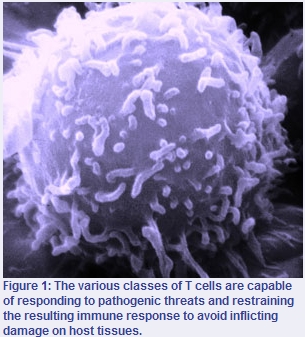기술동향
Following an immune cell’s career path
- 등록일2012-07-09
- 조회수4900
- 분류기술동향
-
자료발간일
2012-07-06
-
출처
Riken Research
- 원문링크
-
키워드
#immune cell#fingerprint# career #career path#pathogen-destroying cytotoxic
Following an immune cell’s career path
A protein ‘fingerprint’ used to identify certain immune cells is expressed more broadly than first thought, raising new questions about how these cells develop
The immune system produces diverse varieties of T cells (Fig. 1), such as pathogen-destroying cytotoxic T cells and immune response-boosting helper T cells. Regulatory T (Treg) cells restrain these other cells and prevent the body from overreacting to threats or generating a dangerous autoimmune response.

Treg cells are usually identified by expression of the tranional regulator protein Foxp3, but new work from a team led by Shohei Hori of the RIKEN Research Center for Allergy and Immunology in Yokohama has demonstrated that this is not a reliable signature1.
Several groups have obtained data suggesting that Treg cells can essentially ‘ careers’, losing their Foxp3 expression and transforming into other T cell types. However, findings from Hori and colleagues led them to propose an alternative ‘heterogeneity model’2. “Our observations suggested that these phenomena can be fully explained by a minor ‘uncommitted’ population of Foxp3+ T cells without assuming reprogramming,” he says. His group has now provided compelling evidence for this hypothesis by using a labeling technique that allowed them to distinguish cells currently expressing Foxp3 from those that are not, but which have expressed this protein in the past.
The researchers identified two groups of Foxp3-expressing cells that responded differently to an immune stimulus. Most expressed this protein stably and at high levels, and exhibited the functional characteristics of Treg cells. A minority fraction displayed transient bursts of Foxp3 expression, but ultimately developed into other T cell types. These ‘exFoxp3’ cells did not appear to represent reprogrammed Treg cells, but rather a separate pool of T cells that only produce this protein sporadically.
Interestingly, his team also learned that some Treg cells do enter a state where they stop expressing Foxp3, although they retain ‘memory’ of their identity as Treg cells. This is achieved via chemical modifications to the DNA within the gene encoding Foxp3, and immune stimulation promptly leads to robust re-expression of this protein. “This should force people to reconsider the popular but oversimplified view of Foxp3 as the master regulator of Treg cells,” says Hori.
The events that determine this expression profile are therefore likely to prove more important in establishing cellular identity than the presence or absence of Foxp3. “It has been speculated that the Treg lineage is determined by a higher-order regulatory pathway upstream of Foxp3, but the nature of this system is unknown,” says Hori. In future work, he plans to partner with colleagues at other RIKEN laboratories to investigate this question more closely.
The corresponding author for this highlight is based at the Research Unit for Immune Homeostasis, RIKEN Research Center for Allergy and Immunology
- Miyao, T., Floess, S., Setoguchi, R., Luche, H., Fehling, H.J., Waldmann, H., Huehn, J. & Hori, S. Plasticity of Foxp3+ T cells reflects promiscuous Foxp3 expression in conventional T cells but not reprogramming of regulatory T cells. Immunity 36, 262?275 (2012). article
- Komatsu, N., Mariotti-Ferrandiz, M.E., Wang, Y., Malissen, B., Waldmann, H. & Hori, S. Heterogeneity of natural Foxp3+ T cells: a committed regulatory T-cell lineage and an uncommitted minor population retaining plasticity. Proceedings of the National Academy of Sciences USA 106, 1903?1908 (2009). article
-
이전글
- Proving the protein-only hypothesis in neurodegeneration
-
다음글
- Synaptopathy, a New Paradigm for Synapse Research

